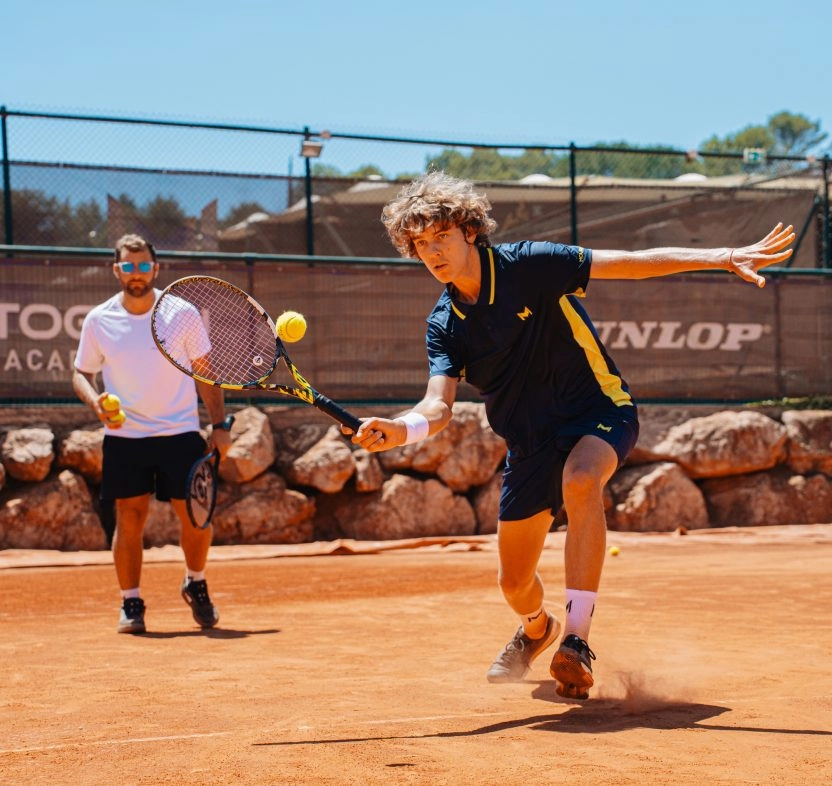In tennis, it’s essential to master the fundamental techniques of the game. It starts with the basics: knowing how to hold your racket properly, learning how to make a good serve, but also how to receive and return the ball effectively. These basics may seem simple and obvious, but they require a certain amount of technique to be effective.
To go further, it’s useful to know the different racket grips. There are several of them, all of which allow you to play in different ways by focusing your strengths on certain points. Whether you’re a beginner, an amateur or dreaming of reaching a high level, mastering these different techniques will enable you to take to the court armed to face different types of opponent.
Discover all our tips for winning at tennis from the Mouratoglou Methodology, taught at our academy, and take advantage of a tennis course at the Mouratoglou Academy with our students, trainees and professional players.
Grips, strikes & forehands

Depending on the way you hold your racket, your position on the court or your objective at any given moment, you need to master different techniques to get the most out of your tennis.
In this article, you can learn about the basics as well as more specific strokes and concepts.
- Firstly, about racket grips: the hammer grip in tennis, the continental grip in tennis and the racket grip in forehands.
- Then, the different types of stroke: the tennis forehand andforehand support, the two-handed backhand andbackhand support.
- Finally, the different ball strokes depending on the situation in the game: the lob technique in tennis, the smash technique in tennis, the perfect bunt in tennis, the offset forehand, the attacking forehand, the finishing forehand, playing a high ball with the forehand, the attacking backhand in tennis, preparing the one-handed backhand, hitting the ball with the two-handed backhand, hitting the one-handed backhand, hitting the return of serve, the volley technique in tennis, and the backhand volley in tennis.
The service

The serve is one of the most important parts of tennis, so it’s important to prepare it well. When it’s time to serve, the player has (almost) all the time in the world to concentrate and prepare the shot. So it’s important to prepare well and refine your technique, using simple tips that you can reproduce.
In this section of the Coaching Corner, you can learn the fundamentals of the putting technique, such as the tennis serve position or the armed position for the tennis serve.
As a server becomes more advanced, he or she will be able to start stringing together combinations such as the volley serve, which allows the server to come up to the net directly after his or her serve to take advantage of the point. There are also ‘surprise serves’, such as the Australian-style serve, which is a non-traditional, spooned serve.
Tactics

Once the serve is done, the game is on. Discover our tips for keeping up the pace on court, surprising your opponent and, above all, not letting yourself be surprised! Depending on your position on the court and in relation to your opponent, learn how to control the game and highlight your strengths.
Tactics in tennis are one of the most important things a player needs to work on. A player can use several tactics, depending on his or her style, the opponent’s style of tennis and the shots played against him or her. In this section of the Coaching Corner, we give you our advice on how to win against a rower in tennis, how to beat a player who goes up on the volley, and how to beat a baseline attacker. We also give you an overview of backcourt tactics and return-of-service tactics in tennis.
To be able to execute a tactic, it’s important to master the technique. That’s why we’ll be coming back to how to work on technique in tennis.

Footwork
Tennis footwork is essential for getting to the ball quickly and positioning yourself effectively. It is based on two fundamental movements: the tennis chassé step, ideal for quick lateral movements, and the tennis cross step, perfect for covering long distances.
Good footwork at the net enables precise adjustments to be made in response to volleys and smashes. Practise these techniques regularly to improve your agility, stability and speed on court.
Frequently asked questions :
-
If you want to make rapid progress in tennis, Mouratoglou tennis clinics are ideal. They offer a personalised programme tailored to your level and objectives, with intensive sessions combining technique, tactics and physical conditioning. Supervised by expert coaches, each course includes video analysis and close monitoring to correct movements in real time. With specific training and tailor-made advice, you have everything you need to improve your game quickly.
-
Learning tennis as an adult is entirely possible, even if it does present a few challenges: adults often have less flexibility and less time to train. However, they have a better understanding of technical instructions and are better able to deal with frustration. With a structured approach and a solid foundation (such as racket grip, placement and movement), it’s possible to make rapid progress. Many clubs offer programmes tailored to adult beginners, enabling them to improve their game in an effective and enjoyable way.









